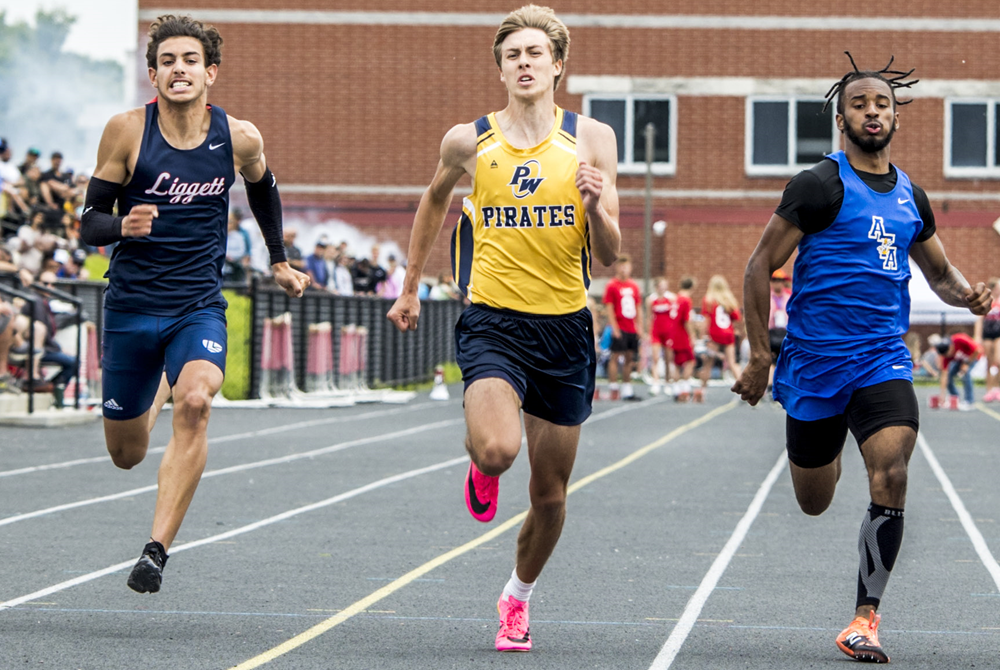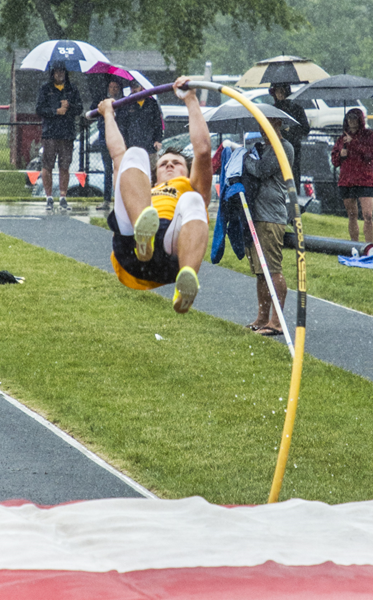
Classes Still Create Hoosier Hysteria
July 27, 2017
By Rob Kaminski
MHSAA benchmarks editor
This is the fourth part in a series on MHSAA tournament classification, past and present, that will be published over the next two weeks. This series originally ran in this spring's edition of MHSAA benchmarks.
Twenty years ago, Bloomington North High School won the Indiana High School Athletic Association boys basketball championship, defeating Delta 75-54 at the RCA Dome in Indianapolis.
The date, March 22, 1997, is at the same time revered and disdained by traditionalists in the state who saw it as the last schoolboy championship game the state would ever host.
That’s how devout the game of basketball, particularly interscholastic basketball, had become in the Hoosier state during the 87 years a state champion – one state champion, to be precise – was crowned.
Following that 1997 season, the IHSAA moved to a four-class system for its roundball tournaments, like so many of its state association counterparts had done years earlier.
It would be shocking to find more than a small percentage of current high school basketball players around the country unfamiliar with the iconic movie Hoosiers, even though the film is now more than 30 years old.
And, the storyline for that blockbuster unfolded more than 30 years prior to its release, when small-town, undermanned Milan High School defeated Muncie Central High School 32-30 in the 1954 IHSAA title game.
Perhaps it’s because of the David vs Goliath notion, or the fame of the movie that replaced Milan with the fictional Hickory and real-life star Bobby Plump with Hollywood hero Jimmy Chitwood, or the simple fact that Indiana had something other states didn’t.
Whatever the reason, plenty of opposition remains to this day to basketball classification in the state.
The fact is, the small rural schools were regularly being beaten handily by the much larger suburban and city schools as the tournament progressed each season.
Small schools also were closing at a rapid rate following the state’s School Reorganization Act in 1959, as students converged on larger, centralized county schools. From 1960 to 2000, the number of schools entering the tournament dropped from 694 to 381, and in 1997 a total of 382 schools and 4,584 athletes began competition at the Sectional level (the first level of the IHSAA Basketball Tournament).
It was at the entry level of the tournament where school administrators felt the pain of the new class system, but not necessarily for the same nostalgic reasons as the fans who either attended or boycotted the tournament.
At the Sectional round of the tournament, the IHSAA was culling just 2 percent of the revenue, with the participating schools splitting the balance. So, when Sectional attendance dropped by 14 percent in that first year of class basketball, many schools realized a financial loss. It was money they had grown to count on in prior years to help fund various aspects of the department.
Schools cumulatively received more than $900,000 from Sectional competition in 1998, but that total was down from more than $1 million in the last year of the single-class tournament.
Yet, the current format provides a great deal more opportunity and realistic chances at championship runs for schools of all enrollments.
To date, 60 additional teams have championship or runner-up trophies on display in school trophy cases around Indiana.
That was the mission in front of then-IHSAA commissioner Bob Gardner (now National Federation executive director) once the board made its decision: to give thousands more student-athletes the opportunity for once-in-a-lifetime experiences.
As any statistician knows, figures can be manipulated to tell any side of a story. Declining attendance in year one of class basketball is such a number.
The truth is tournament attendance had been on a steady downward spiral since its peak of just over 1.5 million in 1962. By the last single-class event in 1997, the total attendance was half that.
The challenge then and today, as it is for all state associations, is to find that delicate balance for those holding onto tradition, those holding onto trophies, and the number of trophies to hand out.
Editor’s Note: Stories from the Fort Wayne Journal Gazette in 1998 and from a 2007 issue of Indianapolis Monthly provided facts in this article.

Smith Sets Tone as Multi-Talented Pewamo-Westphalia Ascends Again
By
Dean Holzwarth
Special for MHSAA.com
June 1, 2024
KENT CITY – Trevor Smith set the tone early for the Pewamo-Westphalia boys track & field team Saturday at Kent City.
The junior sprinter earned a narrow win in the 100 to collect early points that would prove beneficial in the Pirates’ pursuit of their latest Lower Peninsula Division 3 championship.
“It was a big win right away in the beginning, and it helped put us in a good position,” Smith said. “It was a big emotional shift, and it was unreal.
“I didn’t really expect it, but it was a big help toward our team with points. I just missed winning last year, so to come back and win it meant a lot.”
Pewamo-Westphalia kept its early advantage throughout and hung on in the end to capture the title. The Pirates, last year’s runners-up, recorded 49 points to clip second-place Clare by four points. Detroit Edison was third with 32 points.
P-W senior Gavin Nurenberg repeated in the shot put (60-02), while senior Collin Farmer added a pair of top-4 finishes in the distance events.
“Our boys had a really nice season, but this was always the focus from Day 1,” Pirates coach Scott Werner said. “We felt we had the pieces in place when we got out of Regionals, and we were just excited to attack the day.
“We are the type of program where we are good in quite a few events. We don't rely on one person. We set the tone early with unexpected points in the 3,200 relay, and it built from there.”
 Farmer finished runner-up in the 3,200 and fourth in the 1,600.
Farmer finished runner-up in the 3,200 and fourth in the 1,600.
“There are not a lot of teams that have good guys in the field, sprints and distance, so I think that brings a lot of peace to the team,” Farmer said. “We knew that we could trust each other, and not one person had to take control.”
Senior Dalton Brown also provided a lift with a personal record en route to a third-place finish in the shot put.
“I challenged each of the separate groups to go out and score a minimum of 15 points,” Werner said. “We had a plan and an approach for every single event, and they trusted the process and executed at the highest level. I’m proud of them.”
Clare made a late push with a strong showing in the relays, while also receiving a boost from senior Brad White. He cruised to a win in the 800 with a new personal-best time and also was part of the winning 1,600 relay.
“Honestly, I didn't expect this,” White said. “I came into today pressure-free. I’ve already accomplished everything I could ever want in a season, and I'm just as happy as I can be to come out here and do something special, especially in my last high school race. I’m proud of my team and my PR.”
North Muskegon senior Jerry Wiegers repeated in the 400 by edging Geoffrey McBurrow of Detroit Edison. Wiegers also won the 200.
“There was a lot of pressure (to repeat), and I was worried on the whole ride here that I was going to screw up and I was going to have to hand the title to someone else,” Wiegers said. “But when I finally passed the finish line and I won, I was like, ‘I did this again, in my final year in high school.’ It was a good way to cap off my career.”
Coloma senior Boden Genovese (1,600) and Grayling senior Drew Moore (3,200) won the distance races, and Napoleon senior Holden Van Poppel (110) and Elk Rapids junior Max Ward (300) were hurdles champions. Standish-Sterling (400), Edison (800) and Traverse City St. Francis (3,200) also won relays. Lawton junior Mason Mayne (discus), Ovid-Elsie junior Tryce Tokar (pole vault) and Clare sophomore Conan Weeks (long jump) were other field event winners. Grosse Pointe Woods University Liggett senior Jake Juip (100 and 200), Montague junior Wyatt Fairchild (400) and Perry senior Alec Chapman (shot put) won the adaptive event championships.
PHOTOS (Top) Pewamo-Westphalia's Trevor Smith, center, edges Dearborn Advanced Technology's Cobey Cureton and University Liggett's Santino Cicarella, among others, in the 100 on Saturday. (Middle) Ovid-Elsie's Tryce Tokar attempts a vault amid the rainy conditions. (Click for more from Jamie McNinch/RunMichigan.com.)

